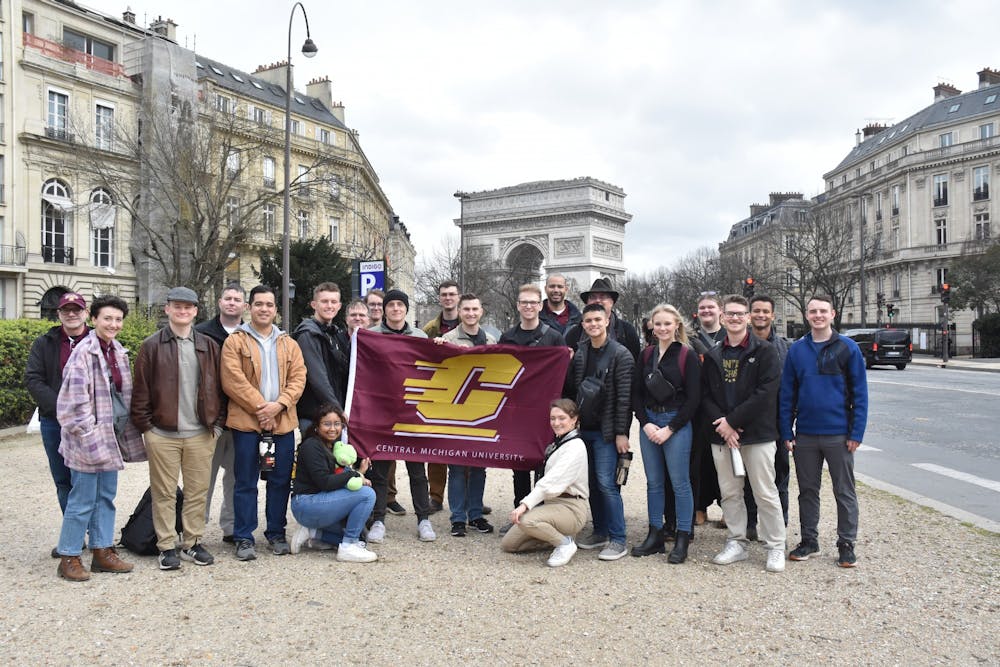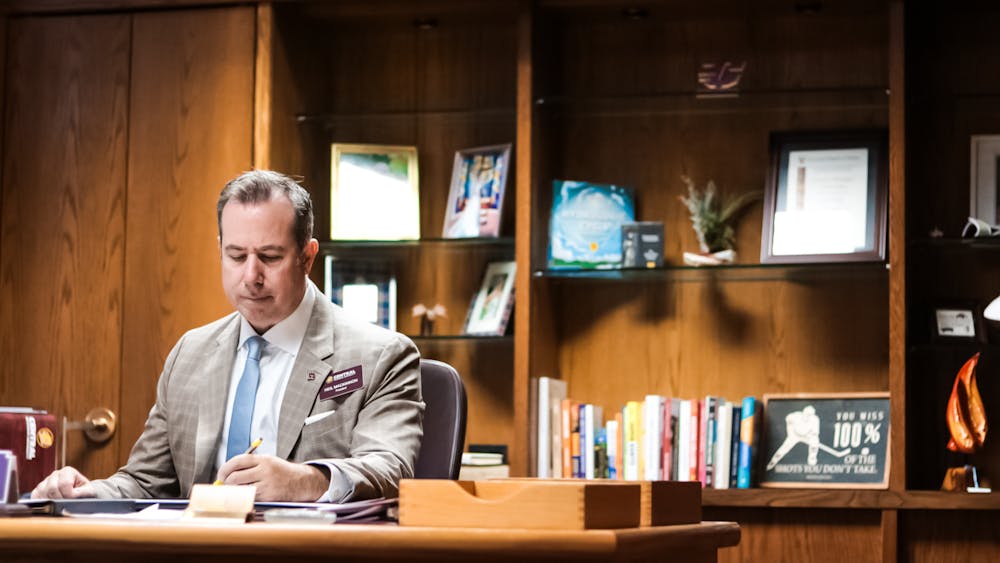Military Science and Museum departments return from spring break in Normandy

Participants in the Central Michigan University Army ROTC Staff Ride pose with the university flag near the Arc de Triomphe. (Courtesy photo/Lt. Col. John Bacon)
The illustration “Kilroy Was Here” may be common in the United States, a relic from the second World War, but it’s even more popular in France.
Jay Martin is the director of CMU’s museum department and he was part of a trip to Normandy, France, organized by the Military Science program at CMU. Before the trip, his students had been drawing the classic cartoon in chalk around campus, but they found it was even more prominent in French museums.
“We saw it in virtually every museum we went to,” Martin said.
Martin said it’s ironic that Museums in Northern France remember the symbol better than a lot of Americans because the symbol was significant to American troops and families even after the war.
For more information about “Kilroy was Here,” this is an article that was published before the trip to Normandy.
The Military Science Department, led by Lieutenant Colonel John Bacon, organized a staff ride to Normandy, France, to learn about the history and military strategy of D-Day and the surrounding events in France during World War II.
They invited members of the museum department to provide historical background, and Christi Brooks -- a French professor in the Department of History, World Languages and Cultures -- to help with the language and cultural barriers.
The group spent their spring break learning about and exploring France.
Learning opportunities
The first part of the trip fulfilled the requirements of the staff ride. Each of the 18 cadets gave at least one presentation on different aspects of the battle at Normandy, as they visited each location.
Bacon said that his 18 cadets had been researching and revising their presentations since the fall 2022 semester.
“CMU Cadet Patrick Scanlon delivered a brief on the armor capabilities of the Allied forces on Omaha Beach, and the armor capabilities are things like tanks,” Bacon said. “He gave some good analysis on how the tanks helped the Allies to win the war.”
Bacon said that another cadet whose work stood out was Cadet Lt. Col. Luke Latoka.
“He gave a brief on the field artillery at Pointe du Hoc, which is where the Second Ranger Battalion climbed hundred-foot cliffs to knock out German artillery that was positioned there,” Bacon said.
The cadets gave their presentations at different locations that related to what they were discussing. To do so, Martin said they visited the American National Cemetery, several beaches, and museums in the area.
According to the American Battle Monuments Commission, the ANC contains over 9,000 graves for fallen American soldiers.
Four of those graves belong to women that Veronica Gregory, a graduate student in the museum department, has been researching.
Gregory said that her research lined up with the information their tour guide presented at the cemetery.
“So that was validating,” Gregory said. “It was like ‘Yes! I got it!’ Anyone that hears that orientation speech will come away with those stories.”
Gregory said three of the four women buried there were members of the postal service.
“They sorted and made sure mail was delivered to soldiers overseas during the last months of the war, and this was incredibly important to keep morale up,” Gregory said. “It’s unique enough to hear about women’s roles in the war and in this capacity. I’ve never heard anything like this before.”
While the group was at the cemetery, cadets from CMU had an opportunity to raise two American flags. Martin said that they received high praise from John Bolt, the assistant superintendent of the cemetery.
“The honor guard of CMU cadets that raised the flag at the American Cemetery at Normandy were highly praised by (Bolt) and his staff by comparison to those that come from other universities to raise the flag for their department in their discipline.”
Joe Monetta is a senior in the museum department at CMU. His research on the two highest-ranking people from Michigan buried at the American National Cemetery also tied into the itinerary.
“One was Maj. James McKinney. ... He was a paratrooper who was born in Detroit and he led a battalion of paratroopers as they fought to take a 20-foot bridge in Normandy,” Monetta said. “It was one of the bloodiest small-unit struggles in all of American military history.”
Monetta said that the other person he researched was Captain Charles Emka from Algonak, Michigan, who was killed while driving his tank onto the beaches at Omaha.
A chance to explore
While most of the presentations and learning experiences were at the beginning of the trip, students and staff had time to explore Paris during the last couple of days.
Martin said their plans were disrupted, however, by the general strike in France. Several of the sites they had planned to visit were shut down or closed early due to the massive number of people on strike.
According to the BBC, the strike is intended to protest changes to the country’s pension plan.
Monetta said he was disappointed to miss seeing the catacombs, but also appreciated the break in an already-full schedule.
Bacon also said that one of the most meaningful stops the group made was to the Vel d’Hiv monument in Paris. Here, he said, was the site of a mass deportation of remaining Jewish people to concentration camps, including several hundred children.
“You can sit in a classroom and you can hear about the Holocaust, and you can hear from survivors and second generation survivors; but until you go there and you’re standing in the neighborhood and you see the memorial firsthand, that’s when it hits home,” Bacon said.






